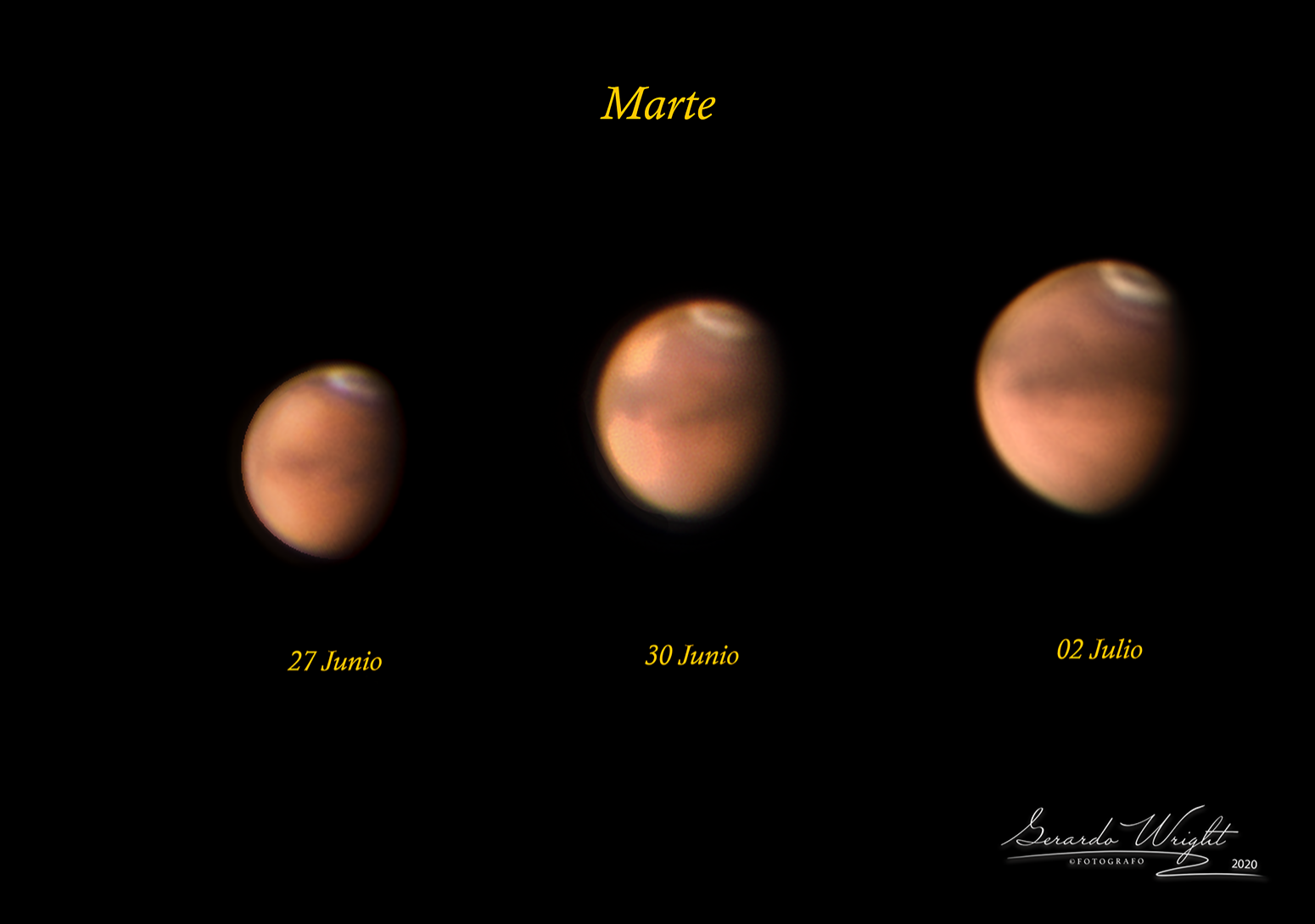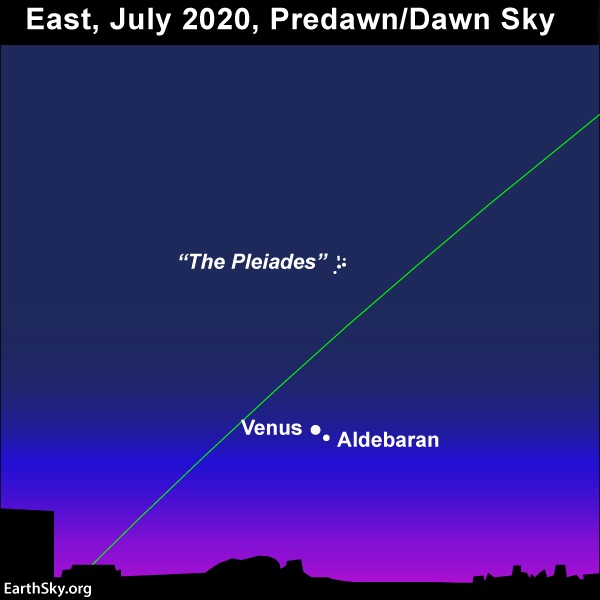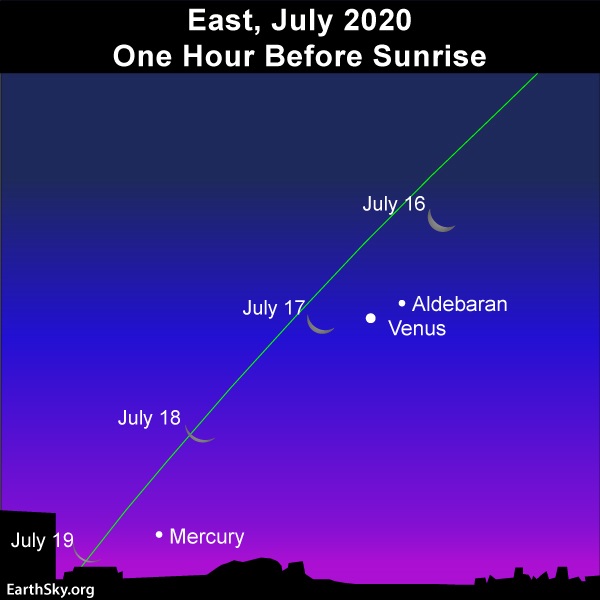
The bright planets Jupiter and Saturn light the eastern half of the sky in early evening now. An even brighter planet, Venus, shines in the east at dawn. Meanwhile, in July 2020, Mars is the bright planet ascending in the east in the middle of the night. Mars isn’t as bright as Jupiter or Venus. And the Red Planet is nowhere close to Venus or Jupiter on the sky’s dome, but instead is found roughly midway between those other two brilliant orbs. The mornings of July 11 and 12, 2020 – from about midnight until dawn – are excellent times to watch for Mars. On these mornings, look first for the moon. The brilliant nearby “star” will be Mars.
Then, once you spot Mars, keep an eye on it in the weeks ahead.
Although the moon will move away from Mars after a few days, you should have little trouble finding Mars in the coming months. Brilliant Mars rules over a relatively “empty” realm of starry heavens, with no nearby bright stars to distract you from this fiery red planet.
Plus Mars will be rising earlier – and earlier – with each passing night. That’s because Earth is now about to catch up to Mars, and pass it, in the race of the planets around the sun. Mars is bright and very red now, and its due to get brighter in the coming months as it approaches its October opposition to the sun. At that time, Earth will be more or less between Mars and the sun. Mars will be opposite the sun in our sky, rising in the east at sundown, blazing very bright and fiery, visible from dusk to dawn.

View at EarthSky Community Photos. | Three days, three recent telescopic views of the Red Planet Mars by Gerardo Wright at Cancun Quintana Roo, México.
Venus and Jupiter rank as the 2nd- and 3rd-brightest celestial objects to light up the heavens, after the sun and moon. Yet, as Mars gets brighter in our sky day and day, it’ll ultimately supplant Jupiter as the 4th-brightest celestial body. That’ll happen in October 2020.
For now, Jupiter is enjoying its moment of glory, as the king planet shining at its brightest for the year.Read more: Jupiter at opposition on July 13-14, 2020
Read more: Saturn at opposition on July 20
Read more: Before 2020 ends, a great conjunction of Jupiter and Saturn

Venus lights up the eastern predawn/dawn sky in July 2020. If you’re up early enough around July 11 – when your morning sky is still dark – watch for the bright star Aldebaran in the constellation Taurus pairing up with Venus on the sky’s dome. Read more.
The moon travels in front of the constellations of the zodiac in an eastward direction, at the rate of about 13 degrees per day. To know which way is east, simply look at the waning moon in your morning sky. The lit side of the waning moon always points eastward (in the direction of sunrise).
So as the moon leaves Mars’ section of the zodiac, it’ll be heading for Venus, to rendezvous with the queen planet in about a week.

Watch for the waning crescent moon to sink downward day by day during the 3rd week of July 2020. It’ll sweep past both Venus and Mercury. Read more.
Bottom line: Jupiter dominates over the July evening sky, staying out from dusk until dawn. Venus, the sky’s brightest planet, lords over the eastern sky at dawn. Mars is roughly midway between Jupiter and Saturn. It’s near the moon on the mornings of July 11 and 12, 2020.
Read more: Year’s farthest quarter moon July 12
from EarthSky https://ift.tt/3gPNpLP

The bright planets Jupiter and Saturn light the eastern half of the sky in early evening now. An even brighter planet, Venus, shines in the east at dawn. Meanwhile, in July 2020, Mars is the bright planet ascending in the east in the middle of the night. Mars isn’t as bright as Jupiter or Venus. And the Red Planet is nowhere close to Venus or Jupiter on the sky’s dome, but instead is found roughly midway between those other two brilliant orbs. The mornings of July 11 and 12, 2020 – from about midnight until dawn – are excellent times to watch for Mars. On these mornings, look first for the moon. The brilliant nearby “star” will be Mars.
Then, once you spot Mars, keep an eye on it in the weeks ahead.
Although the moon will move away from Mars after a few days, you should have little trouble finding Mars in the coming months. Brilliant Mars rules over a relatively “empty” realm of starry heavens, with no nearby bright stars to distract you from this fiery red planet.
Plus Mars will be rising earlier – and earlier – with each passing night. That’s because Earth is now about to catch up to Mars, and pass it, in the race of the planets around the sun. Mars is bright and very red now, and its due to get brighter in the coming months as it approaches its October opposition to the sun. At that time, Earth will be more or less between Mars and the sun. Mars will be opposite the sun in our sky, rising in the east at sundown, blazing very bright and fiery, visible from dusk to dawn.

View at EarthSky Community Photos. | Three days, three recent telescopic views of the Red Planet Mars by Gerardo Wright at Cancun Quintana Roo, México.
Venus and Jupiter rank as the 2nd- and 3rd-brightest celestial objects to light up the heavens, after the sun and moon. Yet, as Mars gets brighter in our sky day and day, it’ll ultimately supplant Jupiter as the 4th-brightest celestial body. That’ll happen in October 2020.
For now, Jupiter is enjoying its moment of glory, as the king planet shining at its brightest for the year.Read more: Jupiter at opposition on July 13-14, 2020
Read more: Saturn at opposition on July 20
Read more: Before 2020 ends, a great conjunction of Jupiter and Saturn

Venus lights up the eastern predawn/dawn sky in July 2020. If you’re up early enough around July 11 – when your morning sky is still dark – watch for the bright star Aldebaran in the constellation Taurus pairing up with Venus on the sky’s dome. Read more.
The moon travels in front of the constellations of the zodiac in an eastward direction, at the rate of about 13 degrees per day. To know which way is east, simply look at the waning moon in your morning sky. The lit side of the waning moon always points eastward (in the direction of sunrise).
So as the moon leaves Mars’ section of the zodiac, it’ll be heading for Venus, to rendezvous with the queen planet in about a week.

Watch for the waning crescent moon to sink downward day by day during the 3rd week of July 2020. It’ll sweep past both Venus and Mercury. Read more.
Bottom line: Jupiter dominates over the July evening sky, staying out from dusk until dawn. Venus, the sky’s brightest planet, lords over the eastern sky at dawn. Mars is roughly midway between Jupiter and Saturn. It’s near the moon on the mornings of July 11 and 12, 2020.
Read more: Year’s farthest quarter moon July 12
from EarthSky https://ift.tt/3gPNpLP

Aucun commentaire:
Enregistrer un commentaire